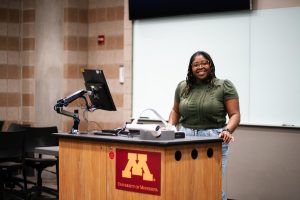The University has a plan. In order to attract more students to living on campus, the University’s long-term master plan, to be implemented in the next 10 years, envisions a campus where necessary goods and services are within convenient walking distance of student housing.
This pedestrian-centered design also includes a reduction in the number of parking lots, ramps and garages — even at a time of expected increases in the influx of adult learners, most of whom will not be living on campus. With fewer places to park, staff members, faculty members and off-campus students obviously will need an alternative to the car, i.e., public transportation.
Continued funding of the Route 52 express bus service at the University will become essential for realization of the University’s long-term master plan. Relying on Metropolitan Council Transit Operations to fill this need would be a mistake. Even though MCTO has recently agreed to finance and provide buses for half of the existing 52 routes into 1998 without cutbacks in service, if the University does not regain funding for the service after 1998, it seems likely that MCTO will revert to its original plan of reducing direct routes to the University. This is probable because the Metropolitan Council’s growth plan for the seven-county area includes the downsizing of its bus system, which already is at the bottom among the nation’s 30 largest metropolitan areas.
A reduction in direct routes to the University will add substantially to commuting time by bus, because riders will need to transfer and travel farther to get to transfer points. Missed classes or work hours caused by missed connections will fairly quickly discourage even the most dedicated buser, especially during winter, resulting in more people driving to the University.
Any such increase will only contribute to the dramatic rise in Twin Cities traffic congestion, and consequent commuting time, projected for the next 20 years. (The number of freeway miles severely congested during rush hour today will more than double by 2020.)
One possible outcome for the University may be difficulties in attracting a quality work force, a consequence predicted for businesses in the core cities as a result of increased commuting time. As one of the top three generators of traffic in the Twin Cities, the University has an obligation to take an active role in reducing congestion. A subsidized bus service is critical for tackling this problem.
As has been shown in parts of Europe and the United States, subsidized mass transit helps slow the rate of growth for traffic congestion and urban sprawl; when fewer people become dependent on cars for lack of alternatives, fewer move to areas accessible only by car, such as the outer suburbs.
Also, lack of adequate parking and public transportation would likely put the University at a competitive disadvantage in recruiting off- campus students, who will still make up a significant portion of the student body.
One proposal for raising funds to support the University’s express bus service and to encourage bus ridership has been to increase the parking rates on campus. Not only are University parking rates currently lower than bus fares, they are also lower than downtown parking rates; University bus fares, on the other hand, are the same as MCTO fares. In effect, the University is subsidizing parking more than transit. Bringing University parking rates in line with the prevailing urban rates, as are bus fares, would go a long way toward providing both adequate public transportation to the University and incentives for its use.
As a premier educational institution, the University should take the lead in committing to sustainable solutions to this problem. If the University can see the wisdom in converting valuable land from parking lots to community services and green areas for its residents, we can only hope that it will also have the foresight to plan for the transportation needs of its very substantial off-campus population.
Wendy S. Larson is an editor in the Graduate School.







